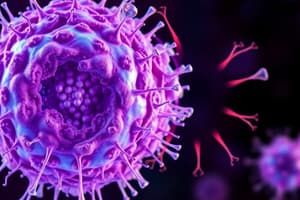Podcast
Questions and Answers
What is the primary role of centrioles in a cell?
What is the primary role of centrioles in a cell?
- They are responsible for protein synthesis.
- They serve as the energy production center.
- They assist in spindle formation during cell division. (correct)
- They regulate the cell's metabolic rates.
What is the process of separating cell components based on their density called?
What is the process of separating cell components based on their density called?
- Filtration
- Distillation
- Electrophoresis
- Density gradient centrifugation (correct)
In microscopy, how is the magnification power determined?
In microscopy, how is the magnification power determined?
- By adding the ocular lens and objective lens values.
- By averaging the values of ocular and objective lenses.
- By multiplying the ocular lens and objective lens values. (correct)
- By dividing the ocular lens value by the objective lens value.
What is the main function of homogenization in cell biology?
What is the main function of homogenization in cell biology?
Which of the following best describes the function of a compound microscope's illumination source?
Which of the following best describes the function of a compound microscope's illumination source?
What type of light source is used in electron microscopy?
What type of light source is used in electron microscopy?
In most plant cells, what structure surrounds the cell membrane?
In most plant cells, what structure surrounds the cell membrane?
Which measurement unit is commonly used for cell size?
Which measurement unit is commonly used for cell size?
Which of the following structures is primarily responsible for locomotion in cells?
Which of the following structures is primarily responsible for locomotion in cells?
Which type of filament is characterized as being solid and contractile?
Which type of filament is characterized as being solid and contractile?
What is the diameter of microtubules compared to microfilaments?
What is the diameter of microtubules compared to microfilaments?
Which structure is composed of 13 protofilaments and is hollow?
Which structure is composed of 13 protofilaments and is hollow?
Which type of cellular structure is most numerous per cell, with a count usually ranging from 300 to 1400?
Which type of cellular structure is most numerous per cell, with a count usually ranging from 300 to 1400?
Intermediate filaments play a critical role in which of the following?
Intermediate filaments play a critical role in which of the following?
What is the primary functional role of microfilaments within the cell?
What is the primary functional role of microfilaments within the cell?
What term describes the soluble part of the cytoplasm?
What term describes the soluble part of the cytoplasm?
What is a characteristic feature of prokaryotic cells in comparison to eukaryotic cells?
What is a characteristic feature of prokaryotic cells in comparison to eukaryotic cells?
Which organelle is exclusively present in eukaryotic cells?
Which organelle is exclusively present in eukaryotic cells?
In terms of ribosome size, what distinguishes prokaryotic ribosomes from eukaryotic ones?
In terms of ribosome size, what distinguishes prokaryotic ribosomes from eukaryotic ones?
Which structure is associated with the function of respiration in eukaryotic cells?
Which structure is associated with the function of respiration in eukaryotic cells?
What term describes the model that represents the structure of the cell membrane?
What term describes the model that represents the structure of the cell membrane?
What primarily differentiates the chromatin material of prokaryotic cells from that of eukaryotic cells?
What primarily differentiates the chromatin material of prokaryotic cells from that of eukaryotic cells?
Which component of the cell is responsible for synthesizing proteins?
Which component of the cell is responsible for synthesizing proteins?
Which of these organelles is primarily involved in packaging and modifying proteins in eukaryotic cells?
Which of these organelles is primarily involved in packaging and modifying proteins in eukaryotic cells?
Flashcards are hidden until you start studying
Study Notes
Prokaryotic and Eukaryotic Cell
- Prokaryotic cells lack a nuclear membrane, meaning there is no distinct nucleus. The genetic material (DNA) is present freely within the cytoplasm.
- Eukaryotic cells have a nucleus enclosed by a double membrane containing the nuclear material (chromosomes).
- Prokaryotic cells have few organelles, and none are surrounded by a double membrane.
- Eukaryotic cells have a wide variety of organelles, many of which are enclosed by double membranes.
- Prokaryotic ribosomes are smaller (70S) with the smaller subunit being 30S and the larger subunit being 50S.
- Eukaryotic ribosomes are larger (80S) with the smaller subunit being 40S and the larger subunit being 60S.
- Prokaryotic cells have cell walls composed of peptidoglycan or murein.
Organelles
- Prokaryotic Cells: Organelles are scarce and often associated with respiration or photosynthesis.
- Eukaryotic Cells: Have a greater diversity of organelles, many bounded by a single membrane.
- Some examples of eukaryotic, single-membrane organelles include lysosomes, vacuoles, microbodies, endoplasmic reticulum, etc.
Chromatin
- Prokaryotic Cells: Chromatin is formed by DNA alone.
- Eukaryotic Cells: Chromatin is composed of DNA and protein.
Studying That Suits You
Use AI to generate personalized quizzes and flashcards to suit your learning preferences.




